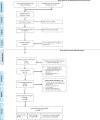Soap versus sanitiser for preventing the transmission of acute respiratory infections in the community: a systematic review with meta-analysis and dose-response analysis
- PMID: 34408031
- PMCID: PMC8375726
- DOI: 10.1136/bmjopen-2020-046175
Soap versus sanitiser for preventing the transmission of acute respiratory infections in the community: a systematic review with meta-analysis and dose-response analysis
Abstract
Objective: To compare the effectiveness of hand hygiene using alcohol-based hand sanitiser to soap and water for preventing the transmission of acute respiratory infections (ARIs) and to assess the relationship between the dose of hand hygiene and the number of ARI, influenza-like illness (ILI) or influenza events.
Design: Systematic review and meta-analysis.
Data sources: Cochrane Central Register of Controlled Trials (CENTRAL), PubMed, Embase, Cumulative Index of Nursing and Allied Health Literature (CINAHL) and trial registries were searched in April 2020.
Inclusion criteria: We included randomised controlled trials that compared a community-based hand hygiene intervention (soap and water, or sanitiser) with a control, or trials that compared sanitiser with soap and water, and measured outcomes of ARI, ILI or laboratory-confirmed influenza or related consequences.
Data extraction and analysis: Two review authors independently screened the titles and abstracts for inclusion and extracted data.
Results: Eighteen trials were included. When meta-analysed, three trials of soap and water versus control found a non-significant increase in ARI events (risk ratio (RR) 1.23, 95% CI 0.78 to 1.93); six trials of sanitiser versus control found a significant reduction in ARI events (RR 0.80, 95% CI 0.71 to 0.89). When hand hygiene dose was plotted against ARI relative risk, no clear dose-response relationship was observable. Four trials were head-to-head comparisons of sanitiser and soap and water but too heterogeneous to pool: two found a significantly greater reduction in the sanitiser group compared with the soap group and two found no significant difference between the intervention arms.
Conclusions: Adequately performed hand hygiene, with either soap or sanitiser, reduces the risk of ARI virus transmission; however, direct and indirect evidence suggest sanitiser might be more effective in practice.
Keywords: COVID-19; health policy; public health.
© Author(s) (or their employer(s)) 2021. Re-use permitted under CC BY-NC. No commercial re-use. See rights and permissions. Published by BMJ.
Conflict of interest statement
Competing interests: None declared.
Figures




Similar articles
-
Effectiveness of handwashing with soap for preventing acute respiratory infections in low-income and middle-income countries: a systematic review and meta-analysis.Lancet. 2023 May 20;401(10389):1681-1690. doi: 10.1016/S0140-6736(23)00021-1. Epub 2023 Apr 27. Lancet. 2023. PMID: 37121242
-
Hand sanitiser provision for reducing illness absences in primary school children: a cluster randomised trial.PLoS Med. 2014 Aug 12;11(8):e1001700. doi: 10.1371/journal.pmed.1001700. eCollection 2014 Aug. PLoS Med. 2014. PMID: 25117155 Free PMC article. Clinical Trial.
-
The relationship between hand hygiene and rates of acute respiratory infections among Umrah pilgrims: A pilot randomised controlled trial.J Infect Public Health. 2024 Apr;17 Suppl 1:34-41. doi: 10.1016/j.jiph.2023.04.003. Epub 2023 Apr 7. J Infect Public Health. 2024. PMID: 37055268
-
Hand washing with soap and water together with behavioural recommendations prevents infections in common work environment: an open cluster-randomized trial.Trials. 2012 Jan 16;13:10. doi: 10.1186/1745-6215-13-10. Trials. 2012. PMID: 22243622 Free PMC article. Clinical Trial.
-
Effect of hygiene interventions on acute respiratory infections in childcare, school and domestic settings in low- and middle-income countries: a systematic review.Trop Med Int Health. 2018 Aug;23(8):816-833. doi: 10.1111/tmi.13080. Epub 2018 Jul 10. Trop Med Int Health. 2018. PMID: 29799658
Cited by
-
The efficacy of soap against schistosome cercariae: A systematic review.PLoS Negl Trop Dis. 2022 Oct 3;16(10):e0010820. doi: 10.1371/journal.pntd.0010820. eCollection 2022 Oct. PLoS Negl Trop Dis. 2022. PMID: 36191022 Free PMC article.
-
Global Experiences of Community Responses to COVID-19: A Systematic Literature Review.Front Public Health. 2022 Jul 19;10:907732. doi: 10.3389/fpubh.2022.907732. eCollection 2022. Front Public Health. 2022. PMID: 35928483 Free PMC article.
-
Identifying gaps in hand hygiene practice to support tailored target audience messaging in Soweto: A cross-sectional community survey.S Afr J Infect Dis. 2022 Mar 31;37(1):339. doi: 10.4102/sajid.v37i1.339. eCollection 2022. S Afr J Infect Dis. 2022. PMID: 35399561 Free PMC article.
References
-
- World Health Organization . WHO coronavirus disease (COVID-19) dashboard, 2021. Available: https://covid19.who.int/?gclid=EAIaIQobChMI8Y7YwLqS7AIVmraWCh0sngONEAAYA... [Accessed 01 Apr 2021].
Publication types
MeSH terms
Substances
LinkOut - more resources
Full Text Sources
Medical
Miscellaneous
